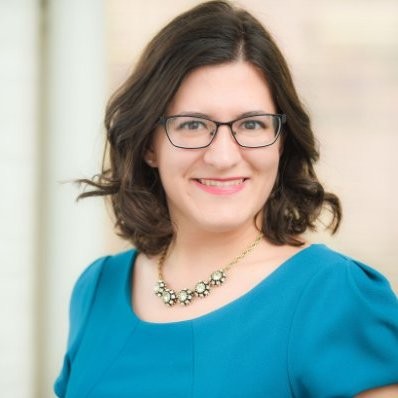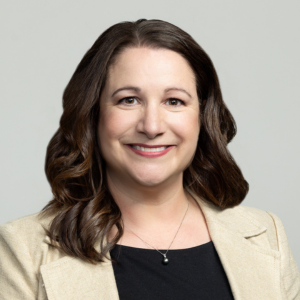Memory masterpieces
Ashley Martin analyzed every brush stroke Tony made. She held her tongue. When she finished, she drew in a breath.
“This is amazing,” Martin says. “When he made decisions I wouldn’t make, it turned out better than what I would’ve done. He opened my eyes. From an art critic’s view, this is not just impressive for someone with dementia, it was impressive for an artist.”
Martin, then a student at Miami University in Oxford, Ohio, spent weekly 90-minute sessions at area nursing homes working with senior artists. Martin and Tony were paired as part of the Opening Minds through Art (OMA), an intergenerational program to help people with dementia and other neurocognitive disorders improve social engagement, autonomy and dignity through creative self-expression.
 |
| "Untitled" by Armondo C. Photo courtesy Miami University Communication and Marketing. |
Elizabeth “Like” Lokon, PhD, founded OMA at Miami’s Scripps Gerontology Center 10 years ago to build meaningful connections. “Arts and craft activities for people with dementia are both too simple and at the same time too difficult,” Lokon says. “A lot of people cannot trace all of those stars and cut them exactly the way it is. When they color, it’s not complete, and they give up because they don’t have stamina. Or they don’t know the location of the eyes, nose and mouth.
"They make mistakes, then staff members help them out and they fall asleep. The only message they’re getting is they can’t do stuff. They can’t even do simple things.”
Lokon works with 70 to 80 Miami students each semester and leads facilitator trainings. The program has since been replicated in more than 50 different locations across the United States, Canada and the Netherlands. OMA was recently designated a Quality Improvement Project by the Ohio Department of Aging. It has been awarded a grant for more than $700,000 from the Ohio Department of Medicaid to help expand the program in nursing homes throughout the state and recognized by LeadingAge Ohio, the National Center for Creative Aging and Generations United.
Artists use professional-grade watercolors, acrylics, oil pastels and collage materials to create abstract art that is complex and full of contrast, textures, colors and juxtaposition. The artistic process is less restrictive than other art media, empowers artists to make decisions and, best of all, is conventionally failure free.
Art and the body
In addition to being aesthetically pleasing, the art has proven health benefits for the artists. OMA is built upon research that making brief, subtle connections multiple times a day improves well-being through unconscious synchronizations in the brain and behavior.
These synchronizations generate the same kind of energy a crowd of strangers feels at a live concert compared to listening to a CD alone at home. The artists see it in the rising cheekbones, shining eyes and crinkled faces of volunteers. Those expressions are unconsciously mimicked and cause positive vibes to be reverberated and amplified.
 |
| A student volunteer watches an artist apply the finishing touches to his creation. Photo courtesy of Miami University Communication and Marketing. |
Those connections release oxytocin, a hormone that makes people appear calmer and more receptive. Lokon says muscles in the middle ear can better separate background noise to become a more attentive listener and eye contact becomes more focused. The body is more attuned.
It’s no surprise, then, that the overall effect is to reduce stress and depression while improving the immune system, cardiovascular health and pain tolerance. Better yet, these connections can be increased through meditation, habit or training.
“That’s why we want to do programming for people who are isolated, who have dementia, who cannot initiate connection to improve their health—both mentally and physically,” Lokon says.
She wanted to see how much artists were interested socially with their partners, how much focus they had on making art and how much they were smiling and laughing in the process. She also wanted to know if they were showing signs of ill-being, such as disengagement, anger, agitation, sadness or confusion.
Through observation, Lokon found artists started very high on engagement and declined as the art project neared completion. However, pleasure and social interest increased after the art was finished because artists attend to one thing at a time. “When they are busy working, they’re not interested socially. But as they’re finished, then they become interested in their partner.”
Lokon detected hardly any ill-being for artists during OMA. What’s more, when comparing the same people participating in OMA, art music therapy, a noncreative activity like reading, no activity and meal time, OMA scored highest on well-being and lowest on ill-being.
A sense of purpose
Beyond the health benefits, the art affords people with dementia the opportunity to learn new skills that offer a new purpose. Lokon recalls an artist who beckoned everyone at an art show to come admire his work. The man was a respected physicist who accrued many awards over his career and held several patents. But, he hadn’t created art before. His wife told Lokon she had never seen him so proud.
“Even people with dementia can develop a new identity,” Lokon says. "Non-artists can become artists, and that’s the term we use. We call them artists because they are artists. We’re all artists. It’s just that we forgot that original creativity we had when we were children. When you have dementia, you’re actually liberated and can have it back.”
OMA pairs artists one-on-one with a college or high school student who has been trained in how to communicate with older people who have cognitive decline. Lokon has worked with nearly 1,200 students at Miami University alone. Some students participate for credit, and some do it as an extracurricular activity. No one has quit or dropped the class, but that doesn’t mean this isn’t an emotional journey for volunteers.
 |
| "Firecracker" by Esta C. Photo courtesy of Miami University Communication and Marketing. |
Lokon administers a dementia attitude scale test to gauge knowledge about and comfort around people with dementia at the beginning and end of the semester. Students journal their experiences. After reading 300 entries, she noticed a trend: students expressed hesitation or apprehension at the beginning, but students typically turnaround by week four or five. Attitudes improve, and students’ social comfort significantly increases. After 10 to 12 weekly sessions, the volunteers are more relaxed, more comfortable and more likely to care for people with dementia. They’re also less afraid and less likely to avoid them.
Martin says she had no idea what to expect with Tony, but seeing him quickly became the best part of her week. He would light up when she walked in and then she would light up, too. The emotions were contagious and led to a great connection.
“I’m an introvert, but I developed this relationship with him,” Martin says. “I had no idea that I could even develop that relationship with a stranger in general. It’s just unbelievable that he had a cognitive barrier, and we were still able to form that bond.”
Read more about volunteer Ashley Martin and artist Tony in The volunteer perspective on memory masterpieces.

Nicole was Senior Editor at I Advance Senior Care and Long Term Living Magazine 2015-2017. She has a Journalism degree from Kent State University and is finalizing a master’s degree in Information Architecture and Management. She has extensive studies in the digital user experience and in branding online media. She has worked as an editor and writer for various B2B publications, including Business Finance.
Related Articles
Topics: Alzheimer's/Dementia , Articles











